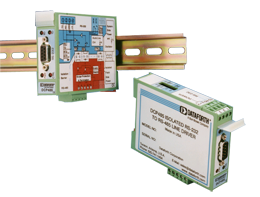an504: Interpreting Drift Specifications
Application Note
- SCM5B30-XX, SCM5B31-XX, SCM5B40-XX and SCM5B41-XX
- Calculating Offset Drift-Multiply the input offset drift spec by the module gain and add the output offset drift spec.
- Calculating Gain Drift-Multiply the gain drift spec by the output range of the module. (For worst case analysis, the module is operated at plus or minus full scale output.)
- Calculating Total Drift-Total Drift = Offset Drift + Gain Drift (For worst case analysis, drift numbers are additive. Therefore, all terms carry the same sign.)
- SCM5B37X and SCM5B47X-XX
- Calculating CJC AccuracyFor Tambient = 25°C, multiply the accuracy (±0.25°C) by the Seebeck Coefficient and the module gain. For 5°C < Tambient < 45°C, multiply the accuracy (±0.5°C) by the Seebeck Coefficient and the module gain. Add this term to the Offset Drift as calculated in Section I.
- SCM5B32-XX
- (±10ppm/°C)(20Ω)(Iz*)(Gain)
- (±10ppm/°C)(20Ω)(Ifs)(Gain)
Read the drift specifications under the Stability heading on the appropriate spec sheet. Determine the overall gain of the module by dividing the output range by the input range.
To determine the drift in volts at a given temperature (°C), subtract 25°C (ambient) from the temperature, then multiply by the offset drift, gain drift or total drift calculated above.
EXAMPLE #1: SCM5B30-03
Input Offset = ±1µV/°C
Output Offset = ±20µV/°C
Gain = ±25ppm/°C
Output Offset = ±20µV/°C
Gain = ±25ppm/°C
Module Gain = [+5V - (-5V)] / [+100mV - (-100mV)] = 50
Offset Drift = (±1µV/°C)(50V/V) + (20µV/°C) = ±70µV/°C
Gain Drift = (±25ppm/°C)(10V) = ±250µV/°C
Total Drift = ±70µV/°C + ±250uV/°C = ±320µV/°C
Worst case drift at 85°C:
Offset Drift(85°C) = (±70µV/°C)(85 - 25°C) = ±4.2mV
Gain Drift(85°C) = (±250µV/°C)(85 - 25°C) = ±15.0mV
Total Drift(85°C) = (±320µV/°C)(85 - 25°C) = ±19.2mV
Read the drift specifications under the Stability heading and the Cold Junction Compensation accuracy from the appropriate spec sheet. Using thermocouple tables to convert the input range to volts, determine the module gain (V/V) by dividing the output range by the input range. Look up the Seebeck Coefficient for the thermocouple type under consideration.
The procedure for calculating drift is the same as in Section I with the exception of adding in the CJC accuracy.
EXAMPLE #2: SCM5B37K
Input Offset = ±1µV/°C
Output Offset = ±20µV/°C
Gain = ±25ppm/°C
CJC Accuracy = ±0.25°C at 25°C;
Type K Thermocouple Output Offset = ±20µV/°C
Gain = ±25ppm/°C
CJC Accuracy = ±0.25°C at 25°C;
±0.50°C 5°C to 45°C
-100°C > -3.553mV
+1350°C > +54.125mV
Seebeck Coef. 40.44µV/°C
+1350°C > +54.125mV
Seebeck Coef. 40.44µV/°C
Module Gain = [+5 - 0V ]/[54.125 - (-3.553mV)] = 86.69 V/V
Offset Drift = (±1µV/°C)(86.69) + (20µV/°C) ±0.50°C(40.44µV/ °C)(86.69) = ±106.7µV/°C ±1.75mV
Gain Drift = (±25ppm/°C)(5V) = ±125µV/°C
Total Drift = ±106.7µV/°C ±125µV/°C ±1.75mV= ±231.7µV/°C
±1.75mV
The procedure for calculating drift is the same as in Section I with the exception of adding the drift of the supplied input resistor
Add the following term to the Offset Drift:
Add the following term to the Gain Drift:
* Iz is the input current which results in zero output
Was this content helpful?
Thank you for your feedback!






